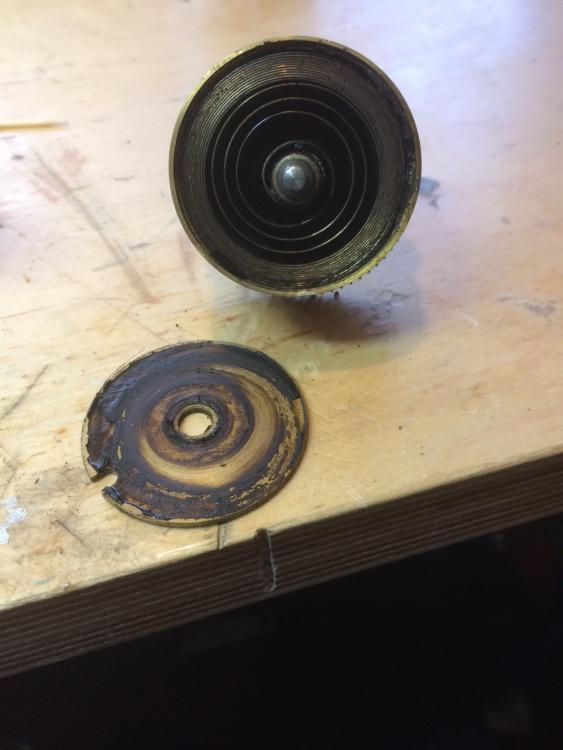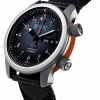Leaderboard
Popular Content
Showing content with the highest reputation on 03/26/18 in all areas
-
2 points
-
Well I finally did it. Dug out the old Hamilton with its demised 500 movement and modified it--just a bit! but not with a 667 Hamilton to make 'Pacermatic' oh no, much more fun with a tuning-fork movement, still 'electric' and still a revolutionary movement, with that graceful seconds hand flow motion. Go Quartz?--You Must be joking! The original 500 movement had broken trip/contact wires, and try as I did, cant find any anywhere. Looks like they went unobtainium sometime last century! I recently got hold of a mens Accutron, I had thought was a 2180, but turned out to be the smaller 2301 so-called, ladies movement in the mens case with a substantial brass spacer-ring. This movement is just a fraction bigger than a British penny, runs at 480Hz with 240 tooth Index-wheel but unlike the other ladies Accutron this caliber has a seconds hand. I dismantled both watches. The coil was dead in the Accutron, so I sourced another complete working watch for £20--Bargain! I serviced the first movement then borrowed the coil from the worker fitted it, where it ran under a glass in its holder for a couple of weeks. I used the now coil-less worker movement as a template for my experiments. I examined the Hamilton movement ring. This part has two projections that serve to retain the battery overhanging the side of the 500 movement, so these would need to be removed. A small grinder took care of that. I now had a more or less round hole in the Hamilton spacer-ring, into which I hoped to fit the Accutron brass spacer. The Accutron spacer was just a little too big, so I reduced its external diameter a little until it fitted the Hamilton ring. I lined up the stem slots and roughly held in position with rodico. fitted the template movement in the middle then came the dial. Here I had a problem. The feet were exactly in line with the outer diameter of the Accutron movement and the inner diameter of Accutron spacer-ring--Bugger, they had to go, which is a shame as I had wanted to retain them, hoped to drill the spacer-ring to accept them, it was not to be! So,--Off they came and the dial feet stumps ground down flush. Again with Rodico (love that stuff!) held the dial to the combo spacer-ring then offered it all into the front case half. Snapped the back on and checked for position of stem hole in movement to case--Amazingly, it was a straight clear shot right into the movement, so I tried the Accutron stem, all good! Out it all came again, so cleaned everything and securely soldered both the spacer-rings together, making one solid part. I then fitted the running movement to the spacer combo after flux and excess solder removed, and reattached the dial with a small amount of double-sided tape, that strong very thin stuff. Only issue now was the hands. The original Hamilton ones are all too big for the Accutron movement, so until I find a solution, I took the original straight gold hands from the mens donor Accutron and cut them to size, fitted them and reassembled back to the case. If you didnt know what a Hamilton Ventura or Pacer is supposed to look like, I guess you wouldnt tell, Its not too bad. The stem proved a Lot easier than I first thought. I shortened the mens case stem and again surprisingly, the Hamilton crown fitted perfectly. Its running now and will take some pics when I strip it all out again to clean the case and crystal, but its nice to wear this frankenstein love-child of two arch rival American watch makers.... --It even has kept time more or less to the second too! Anyone any ideas how I can source or modify hands to fit the Accutron movement so to re gain its correct appearance?2 points
-
1 point
-
I could not find a single video on how to wind a mainspring back into the barrel after cleaning. I purchased a three set tool and figured it out myself and then made a video for others to learn. Thanks Sent from my iPhone using Tapatalk1 point
-
Many thanks for advice. Scattering when not related to magnetism I've found on a watch seemed to be caused by severe wear to the escapement wheel ie.. rounded teeth, which changing the wheel cured the issue. Sent from my SM-T585 using Tapatalk1 point
-
Be reassured that the cheap machine is spot on in this case, showing an extremely poor amplitude. The small beat error is totally believable, as isn't related to the above, and the end result is consistent with what the OP is telling us, poor timekeeping, timing can't be regulated, etc. Now in my experience with these Seiko, the most likely culprit is always the balance assembly, as in distorted hairspring, bent pivots, etc. Fact is, a good 6R15 even if 10 years old, totally dry or strongly magnetized will never behave like that. Anyway, as mentioned above by all of us, a beginner insisting on fighting this type of trouble can only make it worse. Better to stop now as long this can be repaired at a reasonable cost. Even if this is not a very expensive watch, why break things when one can learn on an old 7002 / 7S26 Seiko which will cost like $25.1 point
-
So before I answer the question clarification watch belongs to somebody else and your beginner. This is definitely not a beginner's watch and proceeding beyond this point things get complicated. But you have a question and I will try to answer it. So timing machines don't always give clear answers. It be nice if magically the screen the pop up and tell us exactly what the problem is that they don't yet a very likely never will. So the timing machine has done its job and told us you have a problem watch. First before we get to the problem the watch was purchased a new a year and a half ago but how old is the watch? People forget even if they go to a jewelry store and purchased the watch brand-new how long as it been sitting there and before that in the warehouse conceivably before that from the manufacture even brand-new watches could be several years old. Then there's environmental things like condensation. People claim they never get their watch wet but they take it in the shower with them to wash dishes moisture in the watch is not good for lubrication. So a variety of environmental thing moisture heat being dropped on the floor affect new watches and even old. Then if you look at the data sheets from the watch companies when using a timing machine certain things to be observed. For a fully wound up watch it's allowed to run for a little bit 15 to 60 minutes just to settle down. Then changing positions I know Omega has some very exacting specifications which conveniently I'am not looking at but at least 30 seconds. When changing positions no matter what the watche is going to be a little unstable newer watches much better than old pocket watches. So you always get goofy results if you move the microphone really fast. So timing machine I can go in multiple directions because I'm suspicious of something. First What jumps out is the amplitude it is way too low it is extremely unacceptable. With extremely low amplitude everything gets magnified or basically blown out of shape until it's up to at least 200 everything else is I'm going to be suspicious. But I'm going to ignore that and where we can see what looks like a reasonable trace it looks okay. The beat is interesting that's not great but it's not bad it shouldn't be the reason for the problem. Except usually as amplitude drops the timing machine will show a greater and greater beat error and were not really seeing. The same as rotating from a dial position to a pendant position they hairspring sags you always get a little bit of beat error. My suspicious nature is the beat error looks too good for a watch in this condition if we can believe anything at all. Now we get to the next phase of watch repair if this watch was being repaired. A really good physical examinations starting with the balance wheel. This is a major problem for beginners and all of us from time to time. It is really hard to see what we need to see some watches is almost impossible to see what we need to see and for beginners Is a major problem because you have no idea what you're looking for. Then somewhere probably on the message board there should be a whole step-by-step how to proceed. Simplistically examine the balance wheel see how that looks complete disassembly examining everything is you go. By the way you did demagnetized the watch didn't you? Then I think it was suggested above basically a good overhaul and make sure the hairspring didn't get mutilated when you're moving the regulator around.1 point
-
1 point
-
I cant tell you who made the movement but the case is made by Pierre et Etienne Frainier and the mark on the watch was first registered in 1901 the designs on the case where often signed Frainier usually on a part of the foliage in the design is the back of the case decorated too ? Frainier cases in themselves are quite collectable they where a very small manufacturer. They where manufacturing watch cases from around 1864 to 1930, in a factory in Morteau Fance close to the swiss boarder. The movement is not a cylinder it is a jewelled Swiss lever escapement of reasonably good quality. I would put the watch at no later than 19101 point
-
For the Alum thing, I use a trick.... Bung it all in an old glass Thermos flask overnight. Works a treat as it stays reasonably hot for hours.1 point
-
1 point
-
1 point
-
if it works, good on you...I'd have thought it would be problematic getting it to stay in place and perhaps create balance issues.1 point
-
I need to make a clarification about my post above, I was talking as a general rule only. By no means I recommend that the OP (which has stated to have no experience whatsoever in watch repair) should take apart the movement and/or try to repair it himself. The watch should be given only to a reputable professional. If the cost quoted for repair is excessive an alternative could be to sell it disclosing the issue (around $200), and a new one be bought ($300 or so). Incidentally, the difference is close to the price of a SII NE15 (same as 6R15) replacement mov.t.1 point
-
The best type of machine I have found to make tiny watch staffs and pinions is a watch lathe. The major issue I ran into was having the pinions break off after being turned down past .012 inches or less. A mini lathe has more mass and power with a trade off of less "feel". It was designed for larger size parts, such as clock parts, and can remove metal faster by taking larger cuts. Also, due to more size strength and power, a larger lathe will have less deflection from the cutter pressure thus providing more repeatable accuracy on each cut. That said, no matter how accurate the larger machine is, trying to turn a part down to .004 inches (.1mm) can be difficult or next to impossible due to overpowering the part. Larger parts can, in theory, be made on a watch lathe but a larger more stable lathe would be the better way to go for larger work. If you are going to use the machine to make watch parts (particularly staffs, pinions, stems, tiny screws etc.) I think you will find the watch lathe a better way to go. As I mentioned in previous posts, the Sincere Lathe is the going to be the best and most affordable option for this type of machine. You can always, at a later date, purchase a larger lathe in addition to this to make larger parts. I would also like to mention that some watchmakers will turn the pinion down as far as they can with the turning process and then grind or file it the rest of the way on a Jacot Lathe. This is generally not recommended as it can affect the concentricity and cylindrical properties of the pinion. The final burnishing on the Jacot Lathe should only be used only for the final .01mm -.02mm. This is the difference between making a pivot and making something that looks like a pivot to the naked eye. david1 point
-
1 point






